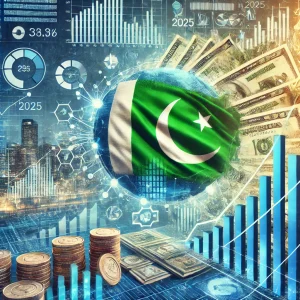Introduction
Pakistan’s economy is at a critical crossroads in 2025. While the country has made progress in stabilizing inflation and increasing foreign direct investment (FDI), significant fiscal challenges remain. With global
economic uncertainties, political transitions, and structural reforms underway,

Pakistan faces both hurdles and opportunities on its path to recovery. This article explores the latest economic indicators, policy measures, and future prospects shaping the nation’s economy.
Macroeconomic Indicators
1. GDP Growth
The International Monetary Fund (IMF) has projected Pakistan’s GDP growth at 3% for 2025, slightly lower than the previous estimate of 3.2%. This figure suggests modest economic progress but highlights the need for deeper structural reforms. Industrial output, agricultural production, and services sectors have seen mixed performances, with some growth in exports and remittances helping balance the economy.
2. Inflation Trends
Inflation in Pakistan has declined significantly compared to previous years. In January 2025, consumer prices increased by 2.4%, a drastic reduction from the 24% inflation rate seen the year before. This decline can be attributed to the government’s monetary policies, currency stabilization efforts, and improved supply chain mechanisms.
3. Fiscal Deficit
Pakistan’s fiscal deficit remains a pressing concern. The federal budget for 2024-25 allocated total expenditures of Rs. 18,900 billion against expected revenues of Rs. 17,815 billion, leading to a fiscal deficit of 6.9% of GDP. This shortfall highlights Pakistan’s ongoing struggle to balance its budget while meeting developmental and social welfare needs.
Monetary Policy and Financial Stability
The State Bank of Pakistan (SBP) has been actively adjusting its monetary policies to support economic stability. In January 2025, the SBP cut the policy interest rate by 100 basis points to 12%, marking the sixth consecutive rate cut since June 2024. Lower interest rates aim to stimulate economic growth by encouraging borrowing and investment, particularly in small businesses and industrial sectors.
External Sector Performance
1. Foreign Direct Investment (FDI)
Pakistan has seen a 37% increase in FDI during the first half of FY2024-25, reaching $1.88 billion compared to $1.38 billion in the same period last year. While this growth is encouraging, Pakistan still struggles to attract large-scale foreign investments due to governance concerns and regulatory bottlenecks.
2. Remittances
Worker remittances have played a crucial role in stabilizing Pakistan’s external accounts. In the first seven months of FY2025, remittances grew 31.7%, reaching $20.8 billion compared to $15.8 billion in the same period last year. This increase has helped offset trade imbalances and contributed to foreign exchange reserves.
3. Trade Deficit
Pakistan’s trade deficit remains a challenge, primarily due to its heavy reliance on imports. The government has taken measures to boost exports, particularly in textiles, IT services, and agricultural products, but a significant reduction in the trade deficit will require long-term policy adjustments and industrial development.
Structural Reforms and Policy Interventions
1. IMF Extended Fund Facility (EFF)
Pakistan is currently under an IMF program worth $7 billion, aimed at restoring economic stability. An IMF team is set to visit Islamabad for a program review, with a focus on fiscal reforms, taxation policies, and debt restructuring. The government’s ability to meet IMF conditions will determine its access to future funding.
2. Energy Sector Reforms
The energy sector has been a major point of concern, with Pakistan renegotiating contracts for wind and solar power projects. However, this move has faced criticism from international investors, including the World Bank’s International Finance Corporation (IFC). Restoring investor confidence in Pakistan’s energy sector is crucial for ensuring sustainable power supply and industrial growth.
Infrastructure Development
Gwadar International Airport
The $240 million Gwadar International Airport, funded by China, remains underutilized. Designed to handle 400,000 passengers annually, its effectiveness is questioned due to Gwadar’s small population of 90,000 and ongoing connectivity challenges. This project highlights the need for better alignment between infrastructure investments and actual economic needs.
China-Pakistan Economic Corridor (CPEC)
CPEC continues to be a key driver of infrastructure development in Pakistan. New road networks, power projects, and industrial zones under CPEC have created jobs and improved connectivity. However, debt repayments to China remain a concern, requiring strategic financial planning to balance development with fiscal responsibility.
Challenges and Opportunities
1. Political Stability and Governance
Political stability remains a major determinant of economic progress. Frequent policy changes, governance issues, and external pressures create uncertainty for investors. Ensuring transparent governance, strong institutions, and consistent economic policies is critical for long-term growth.
2. Agricultural Sector Potential
Agriculture contributes about 20% of Pakistan’s GDP and employs a large segment of the workforce. Improving water management, modernizing farming techniques, and increasing exports can significantly boost economic performance. Pakistan has the potential to become a major food exporter in the region with the right policy interventions.
3. Technology and Industrial Growth
The government has introduced incentives to promote IT and technology-based industries. With a growing number of tech startups, software exports, and digital services, Pakistan is positioning itself as an emerging player in the global IT market. However, investment in education and digital infrastructure will be necessary to sustain this momentum.
4. Tax Reforms and Revenue Collection
Improving tax compliance and revenue collection is essential for reducing fiscal deficits. Expanding the tax base, reducing evasion, and introducing business-friendly tax policies can help increase government revenues without overburdening businesses.
Conclusion
As of 2025, Pakistan’s economy is gradually stabilizing but faces significant challenges in fiscal management, energy sector reforms, and investment confidence. The decline in inflation, growth in remittances, and increase in FDI provide hope for recovery. However, structural reforms, policy consistency, and political stability will be crucial in determining Pakistan’s long-term economic trajectory. By leveraging agriculture, technology, and trade, Pakistan can unlock new opportunities for sustainable growth and development.









